|

by Cap Allon
September 09, 2020
from
Electroverse Website

Parts of the U.S. have gone from balmy summer heat to historic cold
and snow in less than 24 hours. Below is a rebuttal to the
mainstream position that CO2-induced 'Arctic Amplification' is to
blame.
Alarmists claim that the Arctic is warming faster than everywhere
else, and that this phenomenon is weakening
the jet stream.
They say the difference
in temperature between the Arctic and the mid-latitudes fuels the
jet stream, and that a disproportionately warming Arctic is reducing
that temperature difference, weakening the winds to favor a wavier
flow:
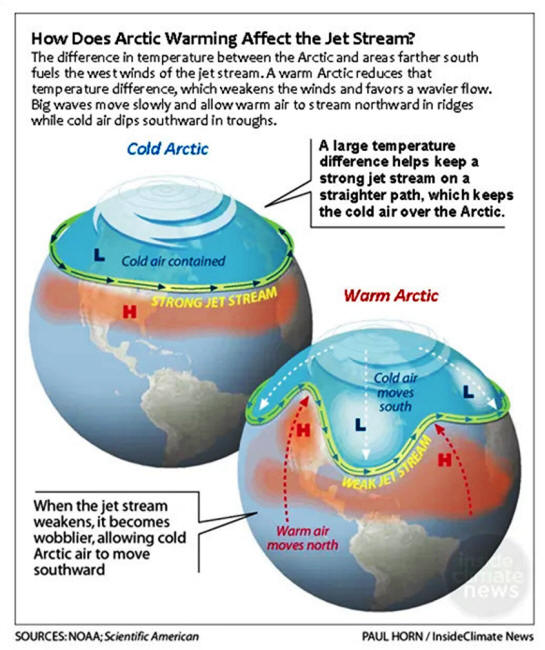
However, at least TWO
insurmountable issues arise with this theory...
Issue 1 - Why
is the Arctic warming faster than everywhere else?
Researchers can't even agree on this one themselves.
However, there is a weak consensus:
the Arctic's reflectivity -
albedo - is reducing due
to 'global warming':
"If the sea ice
melts, that will remove that white surface off of the ocean, and
what will be exposed is this darker ocean surface that will
absorb more of the sun's heat," claims global change ecologist
Isla Myers-Smith.
A simple enough theory
for the layman to understand, and perhaps that's why it was chosen.
Unfortunately for the
alarmists, however, it just doesn't work.
A study led by NASA's
Patrick Taylor explains why:
"It was previously
thought that amplified polar warming was caused by melting ice,
lowering surface albedo," says Taylor.
"Surface albedo at
the poles, however, is lowest in the summer, which is when we
see the weakest temperature response."
Taylor's results suggest
that summertime changes in cloud cover reflects a lot of the sun's
energy, offsetting the low surface albedo, and that it must be
something else that determines the amount of warming:
"The total warming at
the poles is due to changes in clouds, water vapor, surface
albedo and atmospheric temperature," he says.
"But there is greater
warming in the winter than in the summer and that is caused by
energy transport."
Taylor believes this
seasonality of the polar warming is a result of energy in the
atmosphere that is being transported to the poles through large
weather systems, but he concludes that much more study is needed in
order to fully understand the climate sensitivity.
Basically,
AGW-funded scientists don't have an answer as to why the
Arctic is warming faster than everywhere else, but the politics
demands a consensus:
the science must provide policy makers with
all the answers, and all the answers must read 'human CO2
emissions'...
And while it is generally accepted that the Arctic is indeed warming
- slightly - this is more than likely in line with the historically
low solar activity we're currently receiving rather than the
agenda-driving multi-tool that is AGW (Anthropogenic Global Warming).
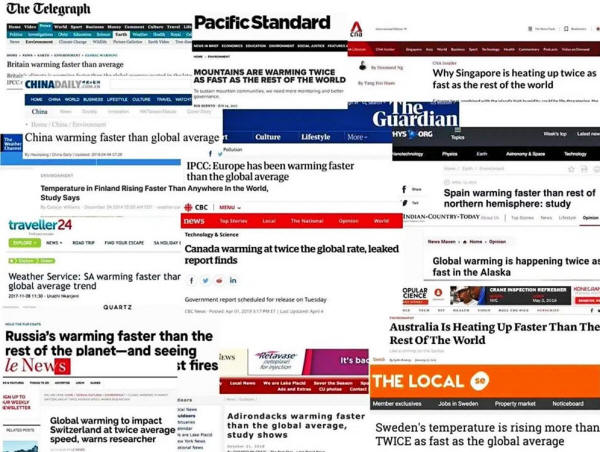
According to a myriad of separate studies,
everywhere would appear to warming twice as fast as everywhere else.
These
studies clearly aren't based in science,
and
are instead are designed to promote fear.
Low Solar
Activity, Cooling, and the Jet Stream
Using NASA's Maunder Minimum Temperature Reconstruction Map
(shown below), it is revealed that while Earth's overall temperature
trends colder during a times of low solar activity, not ALL regions
experience the chill - some areas of the planet actually warm during
spells of otherwise "global" cooling:
the Arctic, Alaska,
and S. Greenland/N. Atlantic to name a few...

Temp change between 1780 (a year of normal solar activity)
and 1680 (a year within the depths of the Maunder Minimum)
NASA.
Research led by Mike Lockwood, a solar-terrestrial physicist
at the University of Reading, UK, found that periods of
low solar
activity are associated with changes in the jet stream, and that,
specifically, a quieter sun means colder winters for Europe.
According to Lockwood, a cooling of the stratosphere - as occurs
during periods of low solar activity - allows the jet streams to
shift towards the Equator.
This has a profound
effect on European weather by causing the northern jet stream to
effectively block warmer maritime air from reaching the continent
from the Atlantic Ocean, and this in turn opens the door to cold,
northeasterly winds to drive anomalously-far south from Russia and
the Arctic.
Lockwood's research, which compared 350 years of central England
temperature data with astronomical observations of sunspots, puts
wavy jet streams firmly at the feet of low solar activity - and
not
global warming - with weather records from as far back as 1650-1700
confirming the pattern.
This era, known as the
Maunder minimum, was a time when
the Sun was virtually sunspot-free
and frost fairs were held on the River Thames:
"Early instrumental
records show that those cold winters were accompanied by cold
winds from the east," explained Lockwood - a theory supported by
MikhaŰl Schwander, et al, 2017.
"The zonal flow
characteristic of westerly types is reduced under low solar
activity as the continental flow for easterly and northerly
types is enhanced.
This is also confirmed by the higher blocking
frequency over Scandinavia under low solar activity."
And Schwander goes
further:
"The 247-year-long
analysis of the 11-year solar cycle impact on late winter
European weather patterns suggests a reduction in the occurrence
of westerly flow types linked to a reduced mean zonal flow under
low solar activity.
Based on this
observational evidence, we estimate the probability to have cold
conditions in winter over Europe to be higher under low solar
activity than under high activity."
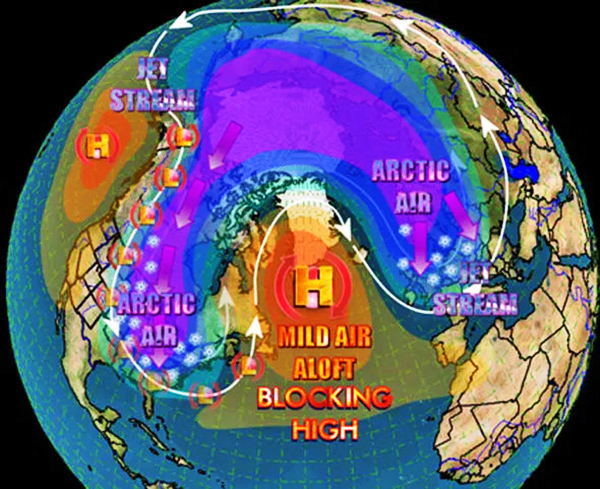
Issue 2 - Why
isn't a similar phenomenon occurring in Antarctica?
Modern climate science states that,
"because the Earth's
polar regions are warming more quickly than the rest of the
world, the temperature contrast that drives jet streams has
decreased" which makes for a weak and wavy jet stream flow.
However, satellite data
reveals that sea ice extent around the southern pole has actually
GROWN over the past 40+years, and also shows that temperatures
across the continent have had no real trend.
According to the AGW 'Polar Amplification' theory, Antarctica should
be mirroring the trends seen in the Arctic:
warming global
temperatures should be melting sea ice exposing the darker sea
beneath, absorbing the heat and increasing temperatures... but
this simply isn't happening.
Furthermore, polar
outbreaks in the southern hemisphere - a wavy jet stream - are also
on the increase, just as they are in its northern counterpart.
There are many, many more issues that cast doubt on the AGW
(Anthropogenic Global Warming) theory,
including ocean circulation cycles and an influx of cloud-nucleating
cosmic rays.
But I'll finish with images and facts re North
America's ongoing historic September cold and snow, which - as
historical documentation and science has shown us - is due to the
impact low solar activity has on the jet stream and not the build-up
of a trace gas in the atmosphere (for more
click here).
Rapid City, SD saw its the earliest measurable snowfall on record on
Tuesday.
The area also set a new low temperature record when the mercury in
downtown Rapid City dropped to 31 degrees - this beat-out the
previous record of 34 degrees set back in 1929.
The past few days busted an all-time U.S. record, too:
Furthermore, and as reported by bismarcktribune.com, the temperature
near the small North Dakota town of Alamo dropped to 18 degrees at
7:08 a.m. Tuesday - that is the lowest temperature ever to hit in
the state on Sept 8.
The snowstorm also broke a record in Casper, Wyoming:
the Oil City
saw its earliest measurable snowfall on record with 2.3 inches
accumulating by midnight Monday.
According to the NSW, Casper's
previous earliest measurable snowfall occurred on Sept 8, 1962.
Cheyenne tied their record for earliest measurable snowfall on
Tuesday as the storm did not produce measurable snow before midnight
Monday.
However, the city did surpass the 0.8 inches recorded back
on Sept 8, 1929, and received more than an inch which beat
Cheyenne's all-time record set while William McKinley was President
back on Sept 10, 1898.
Also:
Hundreds of all-time cold records have fallen over the past few
days.
The COLD
TIMES are returning in line with,
And both NOAA and
NASA appear to agree, if you read between the lines, with NOAA
admitting we're entering a 'full-blown' Grand Solar Minimum in the
late-2020s, and NASA seeing this upcoming 'solar cycle 25'
as "the
weakest of the past 200 years",
with the agency correlating previous solar shutdowns to prolonged
periods of
global cooling.
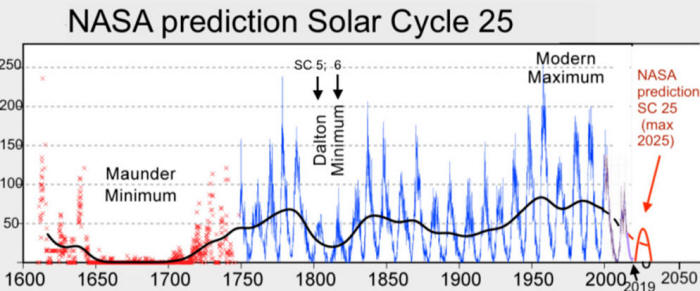
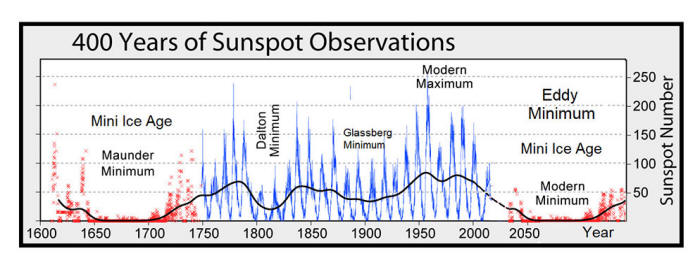
Prepare for the COLD - learn the facts, relocate if need be, and grow
your own...
| 







